In a small primitive tent about 800 meters from the fence separating Gaza from Israel, Fahd Abu Jazar ties crossed wooden hexagonal bars to prepare flaming kites to be flown over the border during the fifth week of “March of Return”.
At the end of the day of the weekly demonstrations, from his tent in Abu Safiyeh neighborhood east of Jabalia, northern Gaza, Fahd prepares 15-20 kites with flaming rags dangling from their tails. They are given to well-known kite operators who Fahd trusts are able to reach the Israeli wheat fields behind the border, causing damage to the Israeli side.

A burning kite for Gaza, April 27, 2018. Photo by Mohammed Asad.
“This is an innovative tactic for demonstrators,” says Fahd, 25, who holds a diploma in library science. “I am proud that I am responsible for three fires broke out last week in those Israeli fields.”
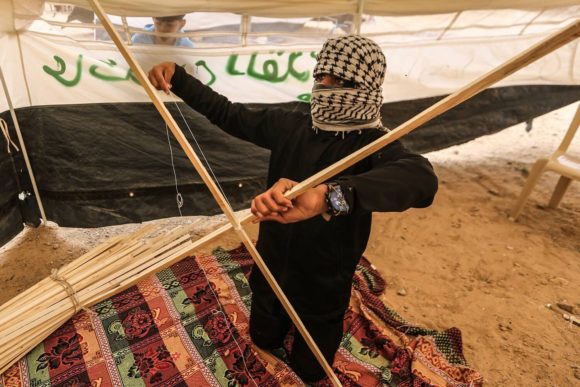
Fahd Abu Jazar prepares a kite in Gaza. Photo by Mohammed Asad.
Last Monday, Four kites affixed with flammable cocktail were sent from Gaza at a wheat field in the Sha’ar HaNegev Regional Council. The fire caused immense damage, torching 25 acres of wheat. “Yediot Ahronot” reported.
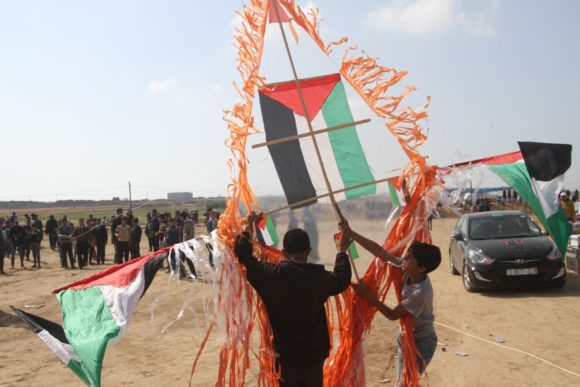
A kite for Gaza, April 27, 2018. Photo by Mohammed Asad.
Israeli farmers in the damaged fields who noticed the kites quickly reached the field and put out the fire using water hoses, while fire teams were called to the scene to assist in taming the flames.

Kite sets a field afire inside Israel. Photo by Mohammed Asad.
In a previous incident, one such Gaza’s kite set to blaze 50 acres in Be’eri Forest, western Israel.
“At first we really did think it was a gimmick, some kind of joke—an incendiary kite—but it turns out we were wrong in a big way. This antiquated weapon is giving us serious trouble and causing heavy damages,” an Israeli farmer told Yediot Ahronot.
The same daily paper reported on Saturday: “Incendiary kite from Gaza sets fire to wheat field in Israel”.
Meanwhile kite flyer Mosbah Abu al-Atta believes that the damage caused by these kites is a big zero compared to what the Israeli troops’ bulldozers have done to Palestinian farmers’ land adjacent to the border.
“Now it is their turn to taste the bitterness when daily incursion on our wheat and pea fields,” Mosbah told Mondoweiss. Farmers in Rafah are being shot at as soon as they plow their lands, he said; and Gaza civilians do not have bulldozers or guns to avenge these attacks.
Mosbah was lighting a bulb affixed to the kite’s tail. The bulb contained coal in a piece of burlap, and doused with diesel fuel and engine oil. His son Mujahed assisted him in directing the kite.
“Let go the string!” Mosbah yelled at his son.
“Usually it goes around 2- 3 miles towards the fields after cutting the string and leaves the burning object to fall in the Israeli farms,” Mosbah added.
Neither father or son has ever taken a plane or a train. They are like more than 90 percent of the young men in Gaza, who have never left the enclave.
The kite is locally dubbed “Tabaq,” Arabic for paper plate. It shares the skies with black Israeli drones, which take films minute by minute of every spot and movement in the devastated coastal territory, a home of two million people squeezed into 140 square miles. Some kites marked with a swastika were seen flying on April 20, which was Nazi leader Adolf Hitler’s birthday.
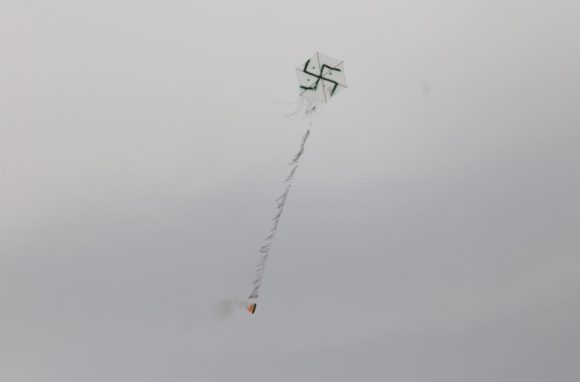
Kite with swastika, April 20, Gaza. Photo by Mohammed Asad.
On Friday, for the first time, Israeli snipers hiding behind the hills warned demonstrators with a loudspeaker to keep back. “Go back, aunt, you are a virtuous lady, we do not want problems,” the loudspeaker said.

Gaza, April 27, 2018. Photo by Mohammed Asad.
I met that woman, Reda al-Banna, 44, and asked her why the soldier asked her to step back. “He speaks politely because he is surrounded by foreign journalists and wants to show up nicely in reports,” she told me.
“Those who are truly polite do not expel people from their lands and occupy their country,” she went on, explaining that she is originally from Jaffa and mother of nine children.
The relative calm continued until 3 pm on Friday. At that time, intense gunfire began with tear gas canister fired by Israeli troops towards thousands of protesters.
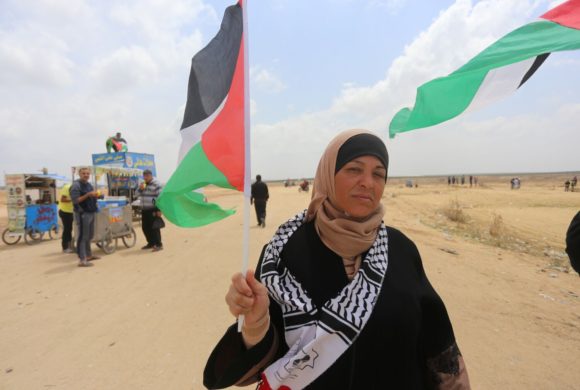
Reda al-Banna. April 27, 2018. Photo by Mohammed Asad.
“Listen, my son,” Mrs. al-Banna said. “I know the situation here well. Foreign journalists have withdrawn and left to their jobs, so now they start using violence.”
By Friday night, three Palestinians had been killed by the Israeli forces along the Israel-Gaza border, according to the Palestinian Health Ministry. At least 833 Palestinians were wounded, said the ministry, despite the UN human rights chief urging Israel to stop using excessive force against Palestinian protesters.

Injured demonstrator, April 27, 2018. Photo by Mohammed Asad.
A fourth victim, a 15-year old boy named Azzam Hillal, died of his wounds on Saturday. He had been shot in the head.
The protests raised the death toll to 45 demonstrators, with more than 6,000 injured, since the mass movement began on March 30.
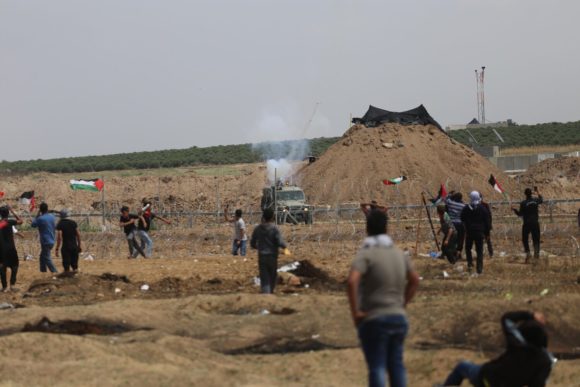
Demonstrators attempt to damage the fence separating Gaza from Israel, April 27, 2018. Photo by Mohammed Asad.
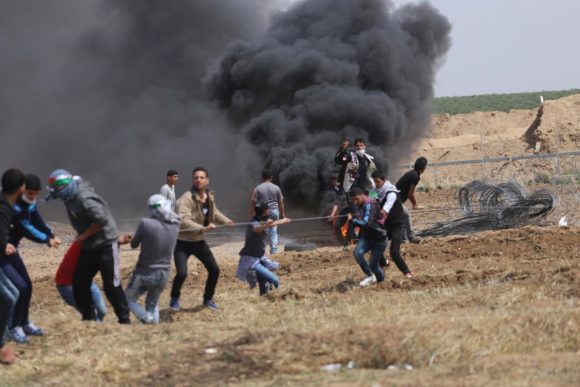
Demonstrators attempt to damage the fence separating Gaza from Israel, April 27, 2018. Photo by Mohammed Asad.
The March organizers believe that more than 30,000 Palestinians participated in Friday’s events, during which attempts were made to damage the security fence and roll burning tires toward the soldiers.

Mohammed al-Fayoumi, who was injured on the second Friday of the march, walks with the help of a crutch to return to the demonstrations. Photo by Mohammed Asad.
Many injured demonstrators have returned to the demonstrations in later weeks.
Mohammed al-Fayoumi, 20, who was injured on the second Friday of the march, was walking with the help of a crutch a kilometer away from the bus stop where demonstrators are dropped.

Injured demonstrator returns, April 27, 2018. Photo by Mohammed Asad.
“On the day of my injury, I remember that the sniper was pointing to me to step back, but I did not respond, so he shot at my feet when I touched the fence,” said al-Fayoumi, an accounting student.
“The doctors advised me to take a rest for two weeks, but I did not pay attention to them,” he added.
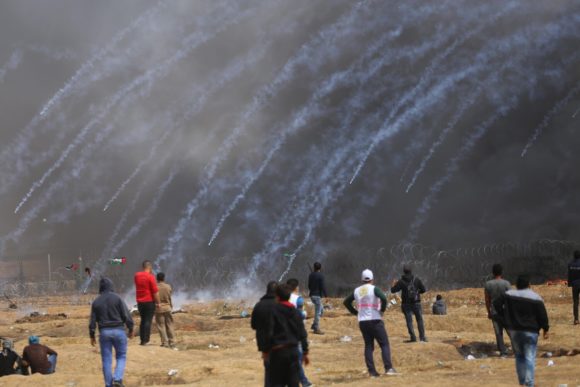
Teargas at demonstrations, Gaza border. April 27, 2018. Photo by Mohammed Asad.
The rallies need to be kept on fire with everyone’s participation, al-Fayoumi said. The situation in Gaza has been frozen for a long time, and daily life is miserable. The demonstrations offer the only hope of political change.
Source Article from http://mondoweiss.net/2018/04/flaming-friday-protests/
 RSS Feed
RSS Feed















 April 30th, 2018
April 30th, 2018  Awake Goy
Awake Goy  Posted in
Posted in  Tags:
Tags: 













